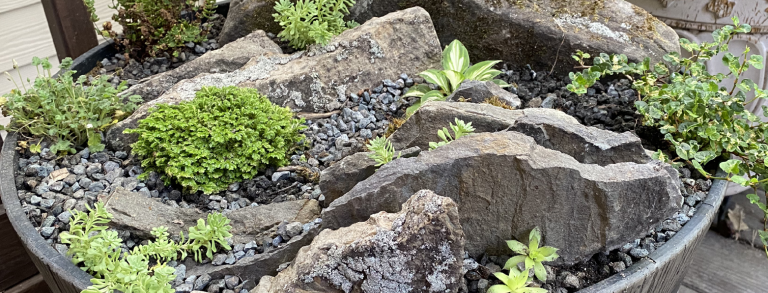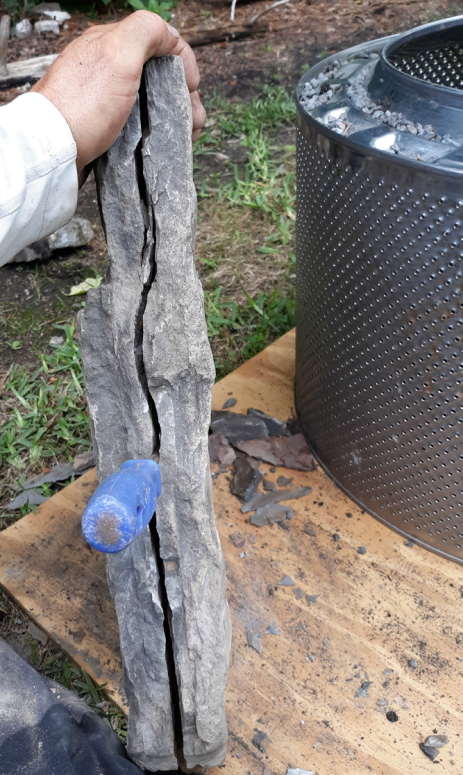Jeremy Schmidt:
In early 2020, Bobby Ward asked if I would like to build a tiny crevice garden in each of two half-barrel-sized outdoor containers. “Sure!” I said.
Having seen several examples of trough crevices online, I knew I had to think much smaller (and thinner) than when constructing large scale crevice gardens, like the 400’ (122 m) long botanical megalith at Juniper Level Botanic Garden. I made a trip to the local stone yard and purchased a pallet of one- to three-inch (2.5 to 7.5 cm) thick “Shiloh Select Thin,” the thinnest naturally weathered stone they offered.
Thanks to a recently deceased front-load washing machine, I had a stainless-steel tub available to tumble my ideas. My initial stainless-steel container crevice looked awful; but much like disassembling a washing machine in the front yard, this was an exercise in learning—not aesthetics. In the trial run, I discovered that my stone selection was too thick to afford any intricacy or flow. Fortunately, the sedimentary flat fieldstone could be split into thinner fragments. Using a $2 flathead screwdriver and an equally cheap carpenter hammer, I bisected a couple dozen choice stones, picking rocks displaying universally useful angles, like long isosceles triangles or trapezoids with concave edges.
With 300 lbs. (about 136 kg) of selected split stone, and enough 75% Permatill™/25% compost soil mix for Bobby’s two containers, it was time to stack.
For the sun container, my objective was to stop the eye from looking past the container. I also wanted to disrupt the symmetry of the container’s rim with some sort of functionally off-balance, overlapping feature. A primary vantage point simplified the design—I only had to make it great from one direction. In an attempt to prevent the eye from speed-reading left to right, all the stones’ elevation was confined to the back left “corner” of the container, promoting front-to-back observation over each horizontal planting crevice.
The second crevice container lives on a shady deck, with primary observation from above. Although functioning as a crevice garden, my goal was to represent the verdant and timeless simplicity of a mossy mountain forest. Hoping to trick the eye into seeing a round boulder resting near exposed rock strata, the mossiest and thickest stone on the pallet was selected to contrast the thinnest slivers of split stone, separated by clear space in between. A second, thick stone was added at an off-angle (top-center) to support the boulder narrative—perhaps they rolled to a stop some time ago. Of course, no ancient forest floor is complete without a celebration of ancient trees. The most difficult part about incorporating deadwood into a container crevice is finding one small enough to fit. This was not the first piece of wood we tried to fit into this container!
What a great project! I had fun with this one. I feel anyone can build a crevice container. The material cost is significantly lower than an in-ground crevice garden, and the stones are all less than 25 pounds (11 kg) each. And if a crevice “draft” is unsatisfactory, one can simply dismantle it and start over. The containers are semi-mobile if set on strong castors or if a hand cart is available. I estimate Bobby’s finished containers at 200 pounds (90 kg) each.
Bobby Ward:
The half-barrels are made of a plasticized high-density resin and were acquired online in the fall of 2019 from Costco, an American-based membership club that operates around the world. The dimensions of the half-barrel are about 20 inches (51 cm) in diameter by 15 inches (38 cm) deep and they cost about $40 U.S.; the color was listed as brown cedar. I placed one on the sidewalk in front of the house, planting it with pansies, a mixture of Viola x wittrockiana that provided color all winter for several months till warm weather began in March of 2020. I did not plant the other half-barrel, but I kept thinking about how I might eventually use both. Searching the internet, I found crevice tubs on a Facebook site called Modern Crevice Gardens. That was my “Eureka!” moment as I decided that I would use the two half-barrels as crevice gardens, one in the sunny front of the house and the other in a somewhat shady space on the back deck.
I had no experience in building a crevice garden but I had seen the work that Jeremy Schmidt had done using recycled concrete (“urbanite”) at Juniper Level Botanic Garden for Tony Avent. I knew the garden well from many visits to see the evolution of Jeremy’s work, particularly when I shopped at the adjacent Plant Delights Nursery. I contacted Jeremy and he accepted the challenge to try his hand for the first time in a small-space crevice garden. The COVID-19 virus slowed things down in early 2020, so it was not until June that Jeremy was able to complete the two half-barrels. For the sunny crevice, Tony Avent gave me small cell packs of plants that would work in the tight spaces of the sunny crevice, and separately I acquired plants from the JC Raulston on-line plant sale and from other area nurseries for the shady crevice half-barrel.
Because of the weight involved, Jeremy decided it was best to build the half-barrels at my house over two visits, so I could see the construction and make any comments, and also avoid the need to load and transport them to my house 45-minutes from where he lived. Once the stones were installed to our satisfaction, my friend, Mike Chelednik, volunteered his eye to design the layout of the plants among the stones and to plant them. For the sunny half-barrel, we used seventeen plants that included Draba kitadakensis, Erysimum helveticum, two species of Escobaria (cactus), Globularia valentina, Echinopsis backebergia (syn. Lobivia beckerbergiana), Saxifraga cotyledon, Campanula rotundifolia, Silene zawadskii and Agave bracteosa ‘Squidget’. The crevice receives mid-morning, direct sun from the south and afternoon sun from the southwest. In the first month after the planting, despite temperatures in the 90s F (30s C), I lost only one plant, an acantholimon, and it was replaced with Escobaria guadalupensis.
For the shady garden, Mike and I made visits to local nurseries to find additional plants that would complement Jeremy’s concept of a mountain forest crevice. Because some of the stones that Jeremy used are larger than those in the sunny crevice, we could only accommodate eleven plants. These included Cheilanthes distans, Erodium reichardii ‘Flore Pleno’, Ficus pumila ‘Dorte’, Hosta ‘Pandora’s Box’, Sedum nevii ‘Silver Frost’, Sempervivum ‘Gold Nugget’, Sedum japonicum ‘Tokyo Sun’ and a fern Astrolepis sinuata ‘Jo Levy’. This half-barrel receives filtered morning sun and bright shade for the rest of the day. Jeremy had envisioned a piece of gnarly deadwood for the forest setting, but it took up too much valuable planting space and was omitted in the final design and plantings.
Working on this project with Jeremy, Tony, and Mike was great fun and educational, and I thank them for their assistance. It’s also a project that can be replicated by others who have moved to an apartment, condominium, or townhouse and have limited space to garden.


